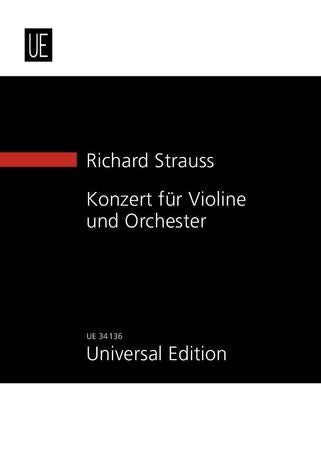
UNIVERSAL EDS/WIENER/PRESSER - 864872
Strauss Concerto for Violin and Orchestra for violin and orchestra - op. 8
Composer: Richard Strauss
Publisher: Universal Edition
Format: Study Score
Strauss Concerto for Violin and Orchestra for violin and orchestra - op. 8
Juilliard Store
144 West 66th Street
New York NY 10023
United States
Choose options

Strauss Concerto for Violin and Orchestra for violin and orchestra - op. 8
Juilliard Store
144 West 66th Street
New York NY 10023
United States
Strauss Concerto for Violin and Orchestra for violin and orchestra - op. 8
Juilliard Store
144 West 66th Street
New York NY 10023
United States
Richard Strauss’ first attempt at a solo concerto embodying several movements was his Violin Concerto in D minor, which he wrote in the spring of 1882 as a 17 year-old. Instead of basing this work on the four-movement symphonic form that Brahms had used shortly beforehand for his Piano Concerto No. 2, he modelled it on the classical three-movement version in which the quick first and last movements flank a slow intermezzo movement in the middle. Whilst even his friend and first biographer, Max Steinitzer, could not answer the question of whether Strauss used a particular concerto as a model, it seems certain that the concertos of Beethoven, Mendelssohn and Bruch – to mention only the German repertoire – acted as catalysts in this respect. Whether or not Strauss had already heard Brahms’s Violin Concerto, though, is unclear. Strauss finished his piece on 22 March 1882, and later recalled having written it – still then in draft form – ’in an exercise book at school’.
The première in Vienna on 5 December 1882, which was instigated by Benno Walter – a cousin of Strauss’s father Franz, to whom he dedicated the work – led to the young Bavarian’s first concert tour. It was here that he first made the acquaintance of his later critics Eduard Hanslick and Max Kalbeck, who received him warmly. The concerto was performed in Vienna – as in subsequent years – in a version for violin and piano, with Strauss himself accompanying Walter. Alongside the violin part, only the piano score found its way into print at the time. It was only in 1896 in Leipzig – with Strauss as conductor and Alfred Krasselt, the lead violinist of the Munich Kaim Orchestra, as soloist – that the piece was first heard in public in its original form. The following year finally saw the publication of the full score.
The fact that the composer of Zarathustra did not scorn the performance of what, from his point of view, was a highly conservative work, may be taken as a mark of the respect that Strauss still bore for his concerto during this period. In fact, the piece aroused considerable interest shortly after its Viennese premiere. The reduction of the orchestral part for the piano did not prove to be a hindrance in this respect, since the reflection of the orchestral music by the piano was something that was completely normal at the time. In early 1883, the Munich reviews praised the ‘brilliant and highly effective treatment of the solo instrument’ and in Berlin, where Strauss spent the winter of 1883/1884 in order to make new contacts and to promote the public performance of his music, he was asked on several occasions for the manuscript of his concerto – which he had taken with him, along with that of several other works – as he then proudly informed his parents. When Strauss became known outside Germany – not only as the composer of the famous symphonic poems, but also in respect of his earlier works – his Violin Concerto appears to have experienced a second bloom. At any rate, in 1903, Strauss reported from Birmingham that the slow movement of the work had ’particularly pleased the provincial English’.
Walter Werbeck, November 2000
